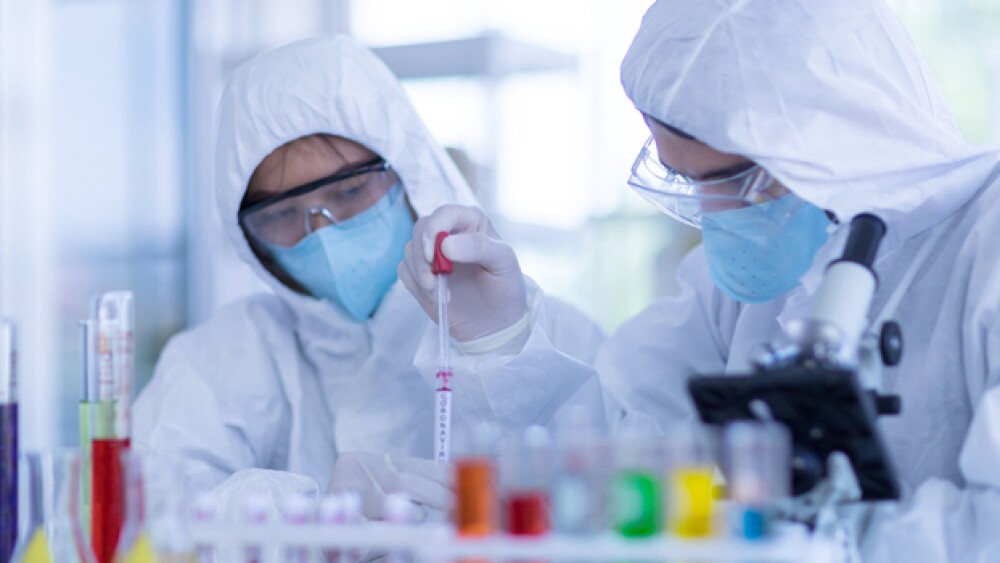Every week there are numerous scientific studies published. Here’s a look at some of the more interesting ones.
Every week there are numerous scientific studies published. Here’s a look at some of the more interesting ones.
How COVID-19 Hijacks the Host Cell
Researchers at Heidelberg University in Germany performed detailed imaging analysis to determine how SARS-CoV-2, the virus that causes COVID-19, reprograms infected cells. It only takes 24 to 48 hours. Their images showed an “obvious and massive change in the endomembrane systems of the infected cells.” These systems allow the cell to define different compartments and sites. The virus causes changes in the membrane so it can produce its own replication organelles, amplifying the viral genome. The researchers describe it as a “massive accumulation of bubbles: two membrane layers forming a big balloon.” The balloons form a shielded compartment where the viral genomes are multiplied and released to incorporate into new virus particles.
“By now we can expect the coronavirus to become seasonal,” said Ralf Bratenschlager, professor in the Department of Infectious Diseases, Molecular Virology, at Heidelberg University. “Thus, there is an urgent need to develop and implement both prophylactic and therapeutic strategies against the virus.”
The changes were observed within a few hours after infection. Because they believe this could be a key to new therapies, they have indicated they wanted the 3D structural information and the other data they collected made available to be used by everyone.
“I believe we are setting a precedent on the fact that we are sharing all data that we produced with the scientific community,” said Yannick Schwab, team leader and head of Electron Microscopy Core Facility at Heidelberg. “This way we can support the global effort to study how SARS-CoV-2 interacts with its host.”
COVID-19 and Sense of Smell
One of the peculiar hallmarks of COVID-19 is the loss of the sense of smell and taste, which affects about 80% of patients. Why how and why? There were early concerns it meant it was affecting the central nervous system, but increasingly the data is suggesting it’s the nasal epithelium. Olfactory neurons don’t have ACE2 receptors, the primary way the SARS-CoV-2 virus infects cells, but sustentacular cells, which support olfactory neurons, do. These cells are involved in the balance of salt ions in the mucus that neurons require to send signals to the brain. When disrupted, it could shut down neuronal signaling and the sense of smell. In recent experiments in golden Syrian hamsters with SARS-CoV-2, sustentacular cells were quickly infected, but olfactory neurons were not. But the olfactory epithelia were completely detached, affecting the cilia that have the olfactory receptors and ability to detect odors. It’s not yet known if this disruption is caused by the virus itself or immune cells reacting to the virus. How the virus affects taste is even less clear. Taste receptor cells don’t have ACE2 receptors either, but support cells in the tongue do.
Molecular Iodine Oral Rinse Effective Against COVID-19
Researchers at the Institute of Antiviral Research at Utah State University compared the antiviral efficacy of four oral rinses. Two were recommended by the American Dental Association, 1.5% hydrogen peroxide and 0.2% povidone iodine. Another, 0.12% chlorhexidine gluconate, received the ADA’s Seal of Acceptance and a fourth, a molecular iodine oral rinse developed by ioTech International, were tested. The testing was performed at a Level 3 Biocontainment laboratory by university researchers. The molecular iodine oral rinse that contained molecular iodine 100 ppm was completely effective within 30 seconds. The others were partially effective, even after 60 seconds. Neither of the iodine rinses were cytotoxic. The hydrogen peroxide and chlorhexidine gluconate rinses demonstrated toxicity.
MMR Vaccine Might Offer Protection Against COVID-19
A new study by the World Organization, in Watkinsville, Georgia, provided supporting evidence that the measles-mumps-rubella (MMR) vaccine might offer protection against COVID-19. They demonstrated that mumps IgG titers are inversely associated with severity in recovered COVID-19 patients who previously received the MMR II vaccine. The MMR II vaccine is produced by Merck and contains the Edmonston strain of measles, the Jeryl Lynn (B-level) strain of mumps, and the Wistar RA 27/3 strain of rubella.
“We found a statistically significant inverse correlation between mumps titer levels and COVID-19 severity in people under age 42 who have had MMR II vaccinations,” said lead author Jeffrey E. Gold, president of World Organization. “This adds to other associations demonstrating that the MMR vaccine may be protective against COVID-19. It also may explain why children have a much lower COVID-19 case rate than adults, as well as a much lower death rate. The majority of children get their first MMR vaccination around 12 to 15 months of age and the second one from 4 to 6 years of age.”
Decoding Telomere Dynamics
The telomeres are the end-tips of chromosomes, made up of long, repeating DNA sequences and binding proteins. If telomeres malfunction, they can’t maintain chromosome stability, which can lead to diseases such as cancer. Telomere shortening is also associated with cell death. Researchers at Kyoto University used a new synthetic probe to visualize chromosome tips in living cells. Unlike other probes used to analyze telomeres, these probes, which used a synthetic pyrrole-imidazole polyamide (PIP) probe, can be used on living cells, are not as time-consuming, and do not denature the DNA with harsh chemicals.
Most Effective Strategies for Decreasing Spread of COVID-19
Investigators with Simon Fraser University developed a model to evaluate the effectiveness of various methods of reducing the spread of COVID-19. These include physical distancing, masks, or social bubbles. They found that physical distancing is the most universally effective. Social bubbles and masks were more situation-dependent. The research created the concept of “event R,” which is the expected number of people who become infected with COVID-19 from a single individual at an event. They included factors such as transmission intensity, duration of exposure, proximity of individuals and degree of mixing. They then leveraged data from reports of outbreaks at various events, such as parties, meals, nightclubs, public transit and restaurants. They found that the likelihood of becoming infected was very dependent on the transmission rate and the duration of time spent in a particular setting. High transmission settings included bars, nightclubs and overcrowded workplaces; low transmission settings included public transit with masks, distancing in restaurants and outdoor activities. They also noted that masks and other barriers may not be as effective in saturated, high-transmission settings, such as parties, choirs, restaurant kitchens, crowded offices, nightclubs and bars.
Frequent, Rapid Testing Key to Crippling COVID-19
A study out of the University of Colorado at Boulder found that when it comes to battling COVID-19, test frequency and test turnaround time are more important than test sensitivity. That is to say, easy-to-access rapid tests are more valuable than the high-sensitivity laboratory tests that may take several days to get a response (or several days to get performed). They believe that testing half the population every week with inexpensive, rapid-turnaround COVID-19 tests could almost eliminate the virus in weeks, even if they’re significantly less sensitive than the gold-standard PCR tests. Essentially, the faster data allows people to self-isolate earlier.
“Our big picture finding is that, when it comes to public health, it’s better to have a less sensitive test with results today than a more sensitive one with results tomorrow,” said Daniel Larremore, lead author of the study and assistant professor of computer science at CU Boulder. “Rather than telling everyone to stay home so you can be sure that one person who is sick doesn’t spread it, we could give only the contagious people stay-at-home orders to everyone else can go about their lives.”





